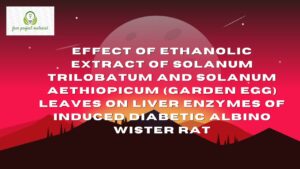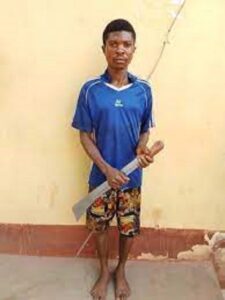ABSTRACT
The study was designed to investigate the effect of organic apple cider vinegar on some liver function parameters of alloxan-induced male diabetic rats. Twenty-five (25) albino wistar rats weighing between 74 – 352g were randomly assigned to 5 groups of rats each. Group 1 which served as the control group was administered commercial rat chow and distilled water only, group 2 served as the negative control and administered 150mg/kg body weight of alloxan, groups 3, 4 and 5 received same dose of alloxan and 0.5ml/kg, 1 ml/kg and 1.5 ml/kg of organic apple cider vinegar for 21 days respectively. All the animals were allowed free access to feeds and water ad libitum. The result revealed that conjugated bilirubin in group 2 significantly decrease (P<0.05), group 3 significantly increase (P<0.05), while group 4 and 5 had a non-significant decrease (P>0.05) when compared to group 1. However, conjugated bilirubin in group 3 significantly increased (P<0.05) while group 4 and 5 showed a non-significant increase (P> 0.05) when compared to the negative group. The result also revealed that mean total bilirubin in group 2 non-significantly decrease (P>0.05) while group 3, 4 and 5 had a significant increase (P<0.05) when compared to control however, group 2 non-significantly increase (P>0.05) when compared to the treated group. The mean serum total protein in all the groups non-significantly decrease (P>0.05) when compared to group 1 except group 5 which showed a significant decrease (P<0.05). Furthermore, total protein non-significantly increase (P>0.05) in 3 and 4 and a non-significantly decrease (P>0.05) in group 5 when compared to negative group. The result also revealed a non-significant increase (P>0.05) of albumin in group 2, non-significance difference in group 3, and non-significance decrease in group 4 while group 5 significantly decrease (P<0.05) when compared to group 1. Albumin in group 3 and 4 non-significantly decreased (P>0.05) while group 5 had a significant decrease (P<0.05) when compared to negative control. Finally, the mean globulin levels in group 2 and 5 significantly decrease while 3 and 4 had a non-significant decrease when compared to group 1. There was also a non-significant increase (P>0.05) in group 3 and 5 while group 4 significantly increase (P<0.05) when compared to negative control. This suggest that apple cider vinegar could provide hepatoprotective properties. Thus, apple cider might be used for the treatment of liver diseases and management of diabetes.
TABLE OF CONTENTS
Title Page – – – – – – – – – i
Certification – – – – – – – – – ii
Dedication – – – – – – – – – iii
Acknowledgement – – – – – – – – iv
Abstract – – – – – – – – – v
Table of Contents – – – – – – – – vi
CHAPTER ONE: INTRODUCTION
1.1 Background of the Study – – – – – – 1
1.2 Aim and Objectives of the Study – – – – 5
1.2.1 Aim of the Study – – – – – – – 5
1.2.2 Objectives of the Study – – – – – – 5
1.3 Scope and Limitations – – – – – – 6
1.4 Significance of the Study – – – – – – 6
1.5 Definition of Terms – – – – – – 6
CHAPTER TWO: LITERATURE REVIEW
2.1 Description of Apple Cider Vinegar – – – – 8
2.2 Processing and safety concerns of Apple Cider Vinegar – 9
2.3 Nutritional Value of Apple cider Vinegar – – – 10
2.4 Health Benefits of Apple Cider Vinegar – – – 12
2.5 Pharmacological Properties of Apple Cider Vinegar – 13
2.5.1 Anti-Diabetic Effects – – – – – – 13
2.5.2 Hypolipidemic Effects – – – – – – 15
2.5.3 Weight control properties – – – – – 18
2.5.4 Management of Hypertension – – – – – 20
2.6 Global Estimation of Diabetes – – – – – 23
2.7 Mechanism of Action of Alloxan – – – – 25
2.8 Biochemical Effect of Alloxan – – – – – 27
2.9 Liver function parameters – – – – – 29
2.9.1 Albumin – – – – – – – – 29
2.9.2 Bilirubin – – – – – – – – 30
2.9.3 Total Protein – – – – – – – 33
2.9.4 Globulin – – – – – – – – 34
CHAPTER THREE: MATERIALS AND METHODS
3.1 Materials – – – – – – – – 36
3.2 Methods – – – – – – – – 36
3.2.1 Sample Collection – – – – – – – 36
3.2.2 Preparation of Sample – – – – – – 37
3.2.3 Experimental Animals – – – – – – 37
3.2.4 Experimental Design and Grouping – – – – 38
3.2.5 Collection of Blood Sample and Preparation of Serum – 39
3.2.6 Determination of Liver functions Parameters – – – 40
3.2.6.1 Determination of Total Protein – – – – – 40
3.2.6.2 Determination of Albumin – – – – – 41
3.2.6.3 Determination of Bilirubin – – – – – 42
3.2.6.4 Determination of Conjugated Bilirubin – – – 43
3.2.6.4 Determination of Globulin – – – – – 44
3.3 Statistical Analysis – – – – – – – 44
CHAPTER FOUR: RESULTS AND DISCUSSION
4.1 Result s – – – – – – – – – 45
4.2 Discussion – – – – – – – – 47
CHAPTER FIVE: CONCLUSION AND RECOMMENDATIONS
5.1 Conclusion – – – – – – – – 53
5.2 Recommendations – – – – – – – 53
References
CHAPTER ONE: INTRODUCTION
1.1 Background of the Study
Diabetes Mellitus (DM) is one of the most common metabolic diseases and is divided according to the mechanism in which the hyperglycemia is generated into two types, dysfunction in insulin secretion and resistance to its activity. Worldwide, the number of people is exponentially increasing mainly due to aging, urbanization, unhealthy eating habits, increasing prevalence of obesity and lack of physical activity. Hyperglycemia is often associated with serious complications, such as liver and intestine toxicities, renal dysfunction, lipid content rises and alterations, retinopathy and cardiovascular disorders and hyperglycemia impaired metabolism of carbohydrate, protein and fat (Elahi-Moghaddam et al., 2013). One of the successful methods for decreasing the onset of diabetes is to control postprandial hyperglycaemia and hyperlipidemia, the inhibition of lipid and carbohydrate hydrolyzing enzymes such as disaccharides and lipase in the intestine. The line of recent researches has been particularly interested to identifying alternative disaccharides inhibitors that can reduce the side effects associated with the currently used antidiabetic drugs. Apple Cider Vinegar as one of the Apple products is a liquid product from fermentation of carbohydrate. Apple Cider is widely used in salad and foods. It has been made and used dating from around 300 BC and is important element in Asian, European, Western and other traditional cuisines of the world (Sultan and Shehata, 2012). The main component of vinegar is acetic acid being present at concentration of 3-5%. Other many medicinal constituents of vinegar include alcohols, peptides, polyphenolic compounds (e.g. gallic acid, catechin, caffeic and ferulic acid), some vitamins, mineral salt, amino acids and organic acids (Budak et al., 2011). Some scientific investigations clearly demonstrated several benefits of vinegar such as antimicrobial properties prevention of hypertension to stimulation of calcium (Ca) absorption and retention, lessening the inflammation lowering serum cholesterol levels, treatment of ear infection colitis external and colitis medial treating warts, reduction is systolic blood pressure and for people with and without diabetes. Several studies clearly demonstrated many benefits of vinegar consumption such as glucose-lowering effect in patient with glucose abnormalities 2007 improved insulin sensitivity in insulin-resistant patients decreasing the glycemic index of carbohydrate food for people with and without diabetes. Several studies clearly demonstrated many benefits of vinegar consumption such as glucose-lowering effect in patient with glucose abnormalities, 2007 improved insulin sensitivity in insulin-resistant patients decreasing the glycemic index of carbohydrate food for people with and without diabetes, antihyperlipidemic, hepatoprotective effect, and modulation of lipid peroxidation (Nazirogw, 2012). One of the most potent methods to induce experimental diabetes mellitus is chemical induction by Alloxan. It is a well-known diabetogenic agent that is used to induce Type 1 diabetes in experimental animals. Alloxan is a urea derivative which causes selective necrosis of the b-cells of pancreatic islets. In addition, it has been widely used to produce experimental diabetes in animals such as rabbits, rats, mice and dogs with different grades of disease severity by varying the dose of alloxan used (Iranloye et al., 2011). As it has been widely accepted that alloxan selectively destroys the insulin-producing beta-cells found in the pancreas, hence it is used to induce diabetes in laboratory animals. The toxic action of alloxan on pancreatic beta cells involve oxidation of essential sulfhydryl (-SH groups), inhibition of glucokinase enzyme, generation of free radicals and disturbances intracellular calcium homeostasis (Dhanesha et al., 2015). The underlying mechanism involves the selective uptake of the compound due to its structural similarity to glucose as well as highly efficient uptake mechanism of the pancreatic beta-cells (Viswanathaswamy et al., 2011). When the cells are removed from the blood, the remaining plasma is composed of water, nutrients, metabolites, hormones, electrolytes and proteins. The plasma proteins serve a number of functions, which include maintaining oncotic pressure, transporting nutrients, metabolites and hormones throughout the body, defending against infection and maintaining the integrity of circulation through clotting.
Many diseases after the amounts of plasma proteins produced and hence, their concentrations in the blood. In the lab we are able to measure levels of various plasma proteins that aid us in making clinical diagnosis and decisions for example-C-Reactive proteins.
1.2 Aim and Objectives of the Study
1.2.1 Aim of the study
The aim of this research project is to determine the effect of organic extract of apple cider vinegar on some liver function parameters of albino wistar rats induced with alloxan.
1.2.2 Objectives of the study
The objectives of this research project were to determine:
- The effect of administration of organic extract of apple cider vinegar on the albumin level of alloxan-induced diabetic rats.
- The effect of administration of organic extract of apple cider vinegar on the globulin level of alloxan-induced diabetic rats.
- The effect of administration of organic extract of apple cider vinegar on the total protein level of alloxan-induced diabetic rats.
- The effect of administration of organic extract of apple cider vinegar on the bilirubin level of alloxan-induced diabetic rats.
1.3 Scope and Limitation of the Study
This research work is limited to the investigation of the effect of co-administration of organic extract of apple cider vinegar on the liver functions (TB, CB, TP, ALB, GLO) of albino wistar rats induced with alloxan. The scope is limited by time as well as financial constraints.
1.4 Significance of the study
The significance of this study lies in its potential to provide valuable insight into the potential therapeutic benefits of apple cider vinegar in the management of diabetes. Understanding the effect of apple cider vinegar on liver function in diabetic rats. Shed light on its potential hepatoprotective properties and its impacts on liver function in the context of diabetes.
1.5 Definition of Terms
Liver Function Test: Is one of the groups of tests that check the level of certain enzymes and other proteins in the blood.
Apple Cider Vinegar: Is the fermented juice from crushed apples. It contains acetic acid and nutrients such as B vitamins & C vitamins. Acetic acid and malic acid combine to give vinegar it sour taste.
Liver: The liver is the largest solid organ in the body. It removes toxins from the body’s blood supply, maintains healthy blood sugar levels, regulates blood clotting and performs hundreds of other vital functions. It is located beneath the rib cage in the right upper abdomen.
Diabetes: Is a chronic diseases that occur either when the pancreas does not produce enough insulins or the cells of the body becoming unresponsive to the hormones effect.
Alloxan: Is a white crystalline pyrimidine derivative C4H2, O4N2, used in biomedical research to induce diabetic in laboratory animals.



